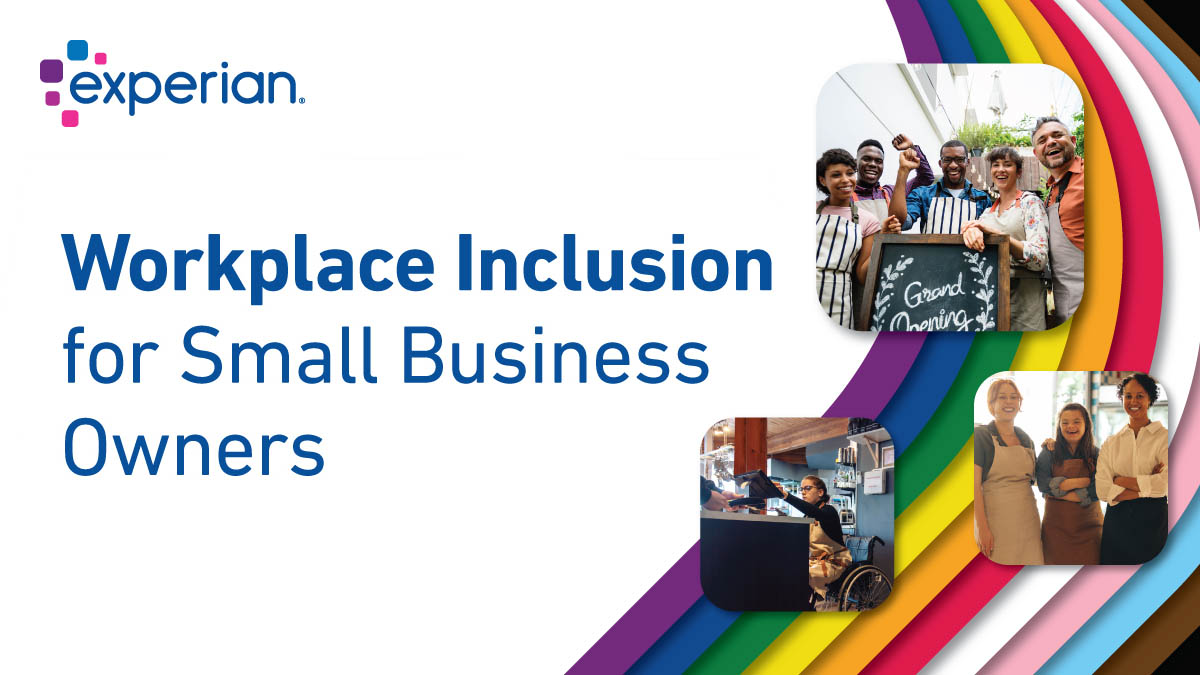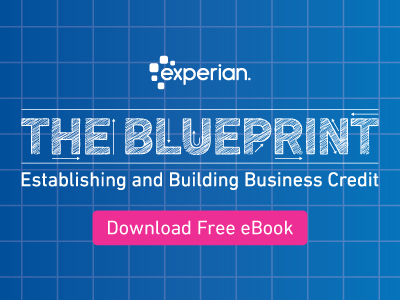
The Benefits of Being an Inclusive Small Business
Creating a workplace environment that embraces diversity and fosters inclusivity is not only a moral imperative; it’s just good business. By actively working to make their work culture more inclusive of LGBTQ+ individuals, companies can enhance employee well-being, productivity, and organizational success. HR managers are realizing that no matter the size or location of their company, when all people feel accepted and free to be themselves at work, everyone wins.
Experian’s Emily Garman hosted a panel discussion with Braxton Fleming, founder of Stealth Bros & Co; Rex Wilde, founder of Rex Wilde Consulting; and Sabrina Kent, Executive Vice President of Programs and External Affairs for the NGLCC (National LGBT Chamber of Commerce) to discuss workplace inclusion for LGBTQ+ employees and customers. For businesses hiring LGBTQ+ team members, and the competition for qualified, loyal staff at a high, business owners who take an inclusivity posture are in a good position to reap the benefits. Here’s a recap of the suggestions and expertise shared on that panel.
Recognize the Unique Challenges
Acknowledging and understanding the distinct challenges faced by LGBTQ+ individuals is the first step towards creating a more inclusive workplace. By recognizing these challenges, organizations can better tailor their strategies to foster inclusivity.
“You can get married in 50 states as an LGBTQ+ person right now. But it over half of the states in this country, you can legally be denied access to credit and financing because you are LGBTQ+,” Sabrina Kent said. “So there are unquestionable barriers to entry for the LGBTQ+ community. And when our identities intersect, whether that be with race, gender, gender expression and so forth, those challenges only become more difficult.”
And challenges absolutely exist for queer people in the workplace. Cisgender people really do have different experiences from people who are non-binary, and even binary trans people. “We will have experiences where if you go into a public space, for example, and there’s only a men’s room and a women’s room. There’s not an all-gender facility available; so from my perspective, as someone who is non-binary, what does that mean for me?” explained Rex Wilde. “That means that I have to think to myself, what is the safest space for me to go into right now, when I’m offered only sex-segregated facilities? It means that I have to assume, okay, what gender am I most likely to be perceived as right now? And then make a choice that doesn’t align with my identity, but feels like the safest option for me in the physical sense.
“So, understanding that those are lived realities and lived perspectives that exist with folks who are a part of the greater trans/gender expansive community is so important. If you want to promote an inclusive culture, remain open to changing perspective to lived experiences of your LGBTQ team members and what’s important to them,” they said.
Elevate LGBTQ+ Success Stories
While it is crucial to address the obstacles, it is equally important to highlight success stories within the LGBTQ+ community. By spotlighting the achievements of willing individuals within their own four walls, companies can inspire others and showcase that success knows no gender or identity boundaries. Sharing narratives of triumph and normalcy within the LGBTQ+ community can dispel misconceptions and encourage greater acceptance.
So how does that work, if you’re a company just starting out? “It could be making sure that the language that you use around your messaging to your customers, to your employees, whomever it may be, is really conscientious of the fact that there are folks that exist across the gender spectrum–men and women and genders in between and beyond that as well,” said Rex Wilde.
Wilde mentioned that when they are working within companies, the reality is that a lot of people haven’t had direct exposure to individuals who are trans, non-binary, or gender expansive (a person whose gender does not conform to gender stereotypes). And because of that, they might not always know what the cultural norms are, or what’s appropriate in terms of things like gender pronouns, or how to ask the right questions. Or if questions that they’re asking about people who are gender diverse are appropriate, and being asked in an appropriate way.
“So,” said Wilde, “If I’m talking to the director of HR at an organization, they really are the stakeholder for being able to help with employee education in that realm. And making sure that employees are able to engage in thoughtful, authentic, and educational conversations around how to be more welcoming to someone who is trans or gender non-conforming. And part of that is just understanding that you might not know the perspective of someone who holds a different identity than you.”
Engage with LGBTQ+ Communities
Building connections and engaging with LGBTQ+ communities is vital for creating an inclusive workplace. Establishing partnerships with organizations like the NGLCC can provide networking opportunities, resources, and access to LGBTQ+ businesses. Participating in local chambers of commerce can also foster connections with LGBTQ+ entrepreneurs, leading to mutually beneficial collaborations.
Sabrina Kent with the NGLCC shared the programs they have available for LGBTQ-owned businesses. “We offer LGBTQ business enterprise certification. This is sort of the gold standard for corporations to confirm that yes, the business is in fact diverse owned. In order to get certified with us, you need to be a member of your local chamber of commerce, and that allows you to really get in on the ground in your local community, start networking and building those connections, and then come to us nationally to be connected with larger national corporate opportunities or even international corporate opportunities, but also have access to work with fellow LGBTQ business owners,” said Kent.
Education and Training
Providing education and training programs for employees is instrumental in fostering an inclusive environment. By enhancing awareness and knowledge, businesses can create a workplace where employees feel comfortable discussing and embracing LGBTQ+ issues.
Here are some specific steps a small business owner can take to make their business more inclusive.
Educate Yourself
Take the time to educate yourself about LGBTQ+ issues, terminology, and experiences. Read books and blogs and other materials designed for business owners (great places to start are Out & Equal and Rex Wilde Consulting). Follow LGBTQ+ business accounts on social media. Listen and learn. Understanding the challenges faced by the LGBTQ+ community will help you make informed decisions and create a supportive environment.
Train Employees
Provide training and educational resources to your employees on LGBTQ+ issues, cultural competency, and respectful communication. This training should promote understanding, sensitivity, and the avoidance of stereotypes or biases. Here are some providers of training modules for small business owners: LGBTQ+ Workplace Education Center, the HRC Foundation, and Family Equality.
Seek Feedback and Input
Actively seek feedback from LGBTQ+ employees and customers on how to improve inclusivity within your business. Engage in open dialogue, listen to their concerns and suggestions, and take their feedback seriously.
Remember that fostering inclusivity is an ongoing process. Regularly review and assess your practices, policies, and workplace culture to identify areas for improvement and ensure that your business continues to be a welcoming space for everyone.
Language and Communication
Language plays a significant role in creating an LGBTQ+ inclusive workplace. Employers should strive to use inclusive language in all communications, whether internal or external. This includes using gender-neutral terms, being mindful of pronouns, and avoiding assumptions about individuals’ identities. Implementing inclusive language guidelines and encouraging open dialogue can contribute to a more respectful and inclusive work environment.
Pronouns
Respect individuals’ pronouns by using them correctly. Ask employees and customers for their pronouns and use them consistently. Provide opportunities for ALL employees (not just LGBTQ+ ones) to share their pronouns in introductions, email signatres, or on name tags.
Gender-Neutral Terms
Replace gender-specific terms with gender-neutral alternatives whenever possible. For example, use “they/them” instead of “he” or “she,” and “spouse/partner” instead of “husband” or “wife.” Encourage employees to use inclusive language in their interactions with customers and clients as well.
Update Forms and Documents
Review your company’s forms, applications, and documents to remove unnecessary gender markers or provide more inclusive options. Use gender-neutral terms like “parent/guardian” instead of “mother/father” and “Mx.” instead of “Mr.” or “Ms.”
Inclusive Job Postings
Craft job postings with inclusive language to attract diverse candidates. Avoid gendered terms like “salesman” or “waitress” and instead use neutral terms like “salesperson” or “server.” Highlight your commitment to diversity and inclusion in the job description.
Customer-Facing Communications
Ensure that customer communications, including emails, newsletters, and social media posts, utilize inclusive language. Avoid assumptions about customers’ gender or sexual orientation. Be mindful of the language used in marketing materials to avoid reinforcing stereotypes.
Feedback and Accountability
Create channels for employees and customers to provide feedback on language use and inclusivity. Regularly review and assess your communication practices to identify areas for improvement. Hold yourself and your employees accountable for using inclusive language consistently.
Remember that transforming language and communications requires ongoing effort and a commitment to learning and growth. Embrace feedback and adapt your approach as societal norms and language evolve.
Supportive Policies and Practices
Establishing policies that promote inclusivity and respect for LGBTQ+ employees is crucial. This can include implementing gender-neutral restrooms, reviewing dress codes and appearance guidelines, and offering comprehensive benefits packages that cover gender-affirming healthcare. Employers should also create mechanisms for reporting discrimination or harassment and ensure swift and appropriate responses.
Develop an Inclusion Policy
Create an inclusive policy that explicitly states your commitment to diversity and inclusion. Include a non-discrimination statement that encompasses sexual orientation and gender identity, and make sure all employees are aware of it. Here are some resources from the US Chamber of Commerce, ADP and Linkedin to get you started.
Foster a Safe Work Environment
To create an LGBTQ+ inclusive workplace, ensure that your workplace is safe and welcoming for all employees. Implement anti-harassment and anti-discrimination policies, and encourage employees to report any incidents or concerns. Take appropriate action to address issues promptly and maintain confidentiality.
Offer Inclusive Benefits
Review your employee benefits package to ensure it is inclusive. Consider offering transgender-inclusive healthcare coverage, recognizing diverse family structures, and providing mental health resources that are sensitive to LGBTQ+ issues.
Support LGBTQ+ Causes
Show your support for the LGBTQ+ community by sponsoring local LGBTQ+ events, supporting LGBTQ+ organizations, or participating in Pride Month activities. This demonstrates your commitment and can help build goodwill within the community.
Encourage Allyship
Employers can cultivate an LGBTQ+ inclusive workplace where allies actively support and advocate for their LGBTQ+ colleagues. Establishing employee resource groups (ERGs) or affinity groups can provide a platform for open discussion, networking, and support.
Creating an LGBTQ+ inclusive workplace requires a deliberate and ongoing commitment from businesses. All of these things add up, so it’s important for companies to get as many of these things right as they can, in terms of creating a welcoming environment for employees, coworkers, and clients. It’s why using people’s pronouns correctly is important. It’s why having gender neutral bathrooms matters. It’s why dress codes and appearance guidelines are a big deal. Because the more time that somebody has to spend masking their true self, or trying to fit in, or is afraid to talk about their family, the less they are able to focus on their work and doing their job. And that’s something that people who are straight, who are cisgender, who fit in the binary, just don’t usually consider.
Embracing diversity and inclusivity benefits not only individual employees, but also the overall success and growth of businesses. Companies should strive to create workplaces that celebrate authenticity and embrace the rich tapestry of human experiences.
